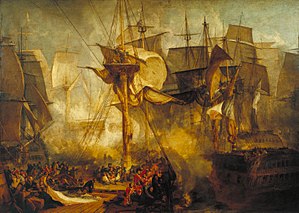Battle of Trafalgar
The Battle of Trafalgar was a sea battle fought on 21 October 1805 between the navies of France and Spain on one side and United Kingdom on the other. The battle took place near Cape Trafalgar, in southwestern Spain. The battle ended with a clear victory for the British forces and allowed Britain to become the world's largest sea power for 100 years. It was the most important sea battle of the 19th century.

Background
changeThe Napoleonic Wars had gone on for some time. France had built the strongest army in Europe and controlled much of its land. Because they lived on islands, the British had built a strong Royal Navy and used it to blockade France to prevent its ships from leaving their ports. The French leader, Napoleon Bonaparte, wanted to invade and to conquer Britain, which meant that he had to sink the Royal Navy before his army could land there.
The British knew that France might try to attack them and so placed ships outside the important French ports like Toulon. The admiral in charge of the British fleet was Lord Horatio Nelson. He had become famous in Britain for his victories over the French such as at the 1798 Battle of the Nile.
However, the French Navy managed to avoid Nelson's fleet, left Toulon during a storm and met a group of Spanish ships. Spain then an ally of France. The small fleet first sailed to the West Indies and returned across the Atlantic Ocean to the Spanish port of Cadiz. The fleet wanted to join with more French ships to make a stronger fleet. The British had chased them both ways across the ocean.
Battle
changeThe French learned that some British ships had been seen in Gibraltar and thought that meant that the British fleet was less strong than it had been. The French decided that it was the best time to leave Cadiz.
The next day, the 33 ships of the French and the Spanish fleets were met by the 27 ships of the British.[1] Nelson had put his ships into two lines. Before the battle started, he sent a message that would become famous: "England expects that every man will do his duty".[1]
The two British lines sailed through the French and Spanish line, split it and caused great damage to its ships by using their cannons
However, on board his ship, HMS Victory, Nelson was hit by a musket bullet fired by a sniper from the French ship Redoutable.[1][2] The bullet entered via his shoulder, went into his lung and lodged in his spine.[2] He was taken below the deck and died shortly before 4:30pm, as the battle was dying down.[2] The French and Spanish had lost 22 ships, but the British lost none.[3]
Aftermath
changeBecause France was unable to invade Britain, British soldiers fought on Continental Europe with the armies of other countries against those of Napoleon. In the end, Napoleon was finally defeated in 1815 at the Battle of Waterloo. With control of the seas, Britain built up a large empire during the years that followed, and the Royal Navy was the world's largest navy for over 100 years.[4]
Nelson's body was brought back to Britain, where he was given a hero's funeral. In 1843, the famous Trafalgar Square and Nelson's Column were built in London to honour him.
References
change- ↑ 1.0 1.1 1.2 Iggulden, Hal; Iggulden, Conn. The Dangerous Book for Boys (2006), pp. 154 - 158. HarperCollins Publishers.
- ↑ 2.0 2.1 2.2 Lambert, Andrew (2011-02-17). "The Battle of Trafalgar". BBC.
- ↑ Clayton, Tim; Craig, Phil 2004. Trafalgar: the men, the battle, the storm. Hodder & Stoughton. ISBN 0-340-83028-X
- ↑ Lambert, Andrew 2000. War at sea in the age of sail. ISBN 1-55278-127-5